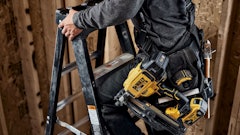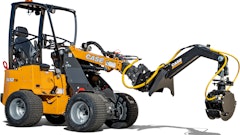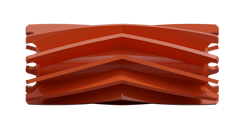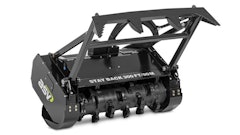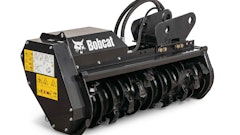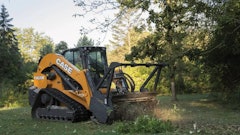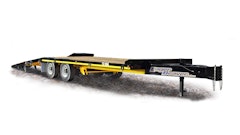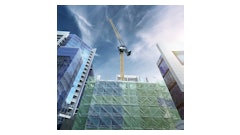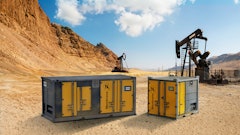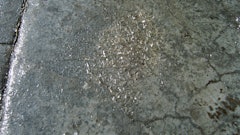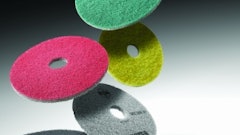
Winter is coming. In parts of the upper Midwest, snow falls in measurable inches by Halloween each year. Preparing for the possibility of a late-October snowstorm is wise. Whether you have a small business or a big residential yard to clear, consider a skid-steer loader to move snow this winter.
Featuring a tight turning radius–skid-steer loaders can turn within their own length–the machines’ maneuverability and agility make them popular for removing snow in the tightest quarters, such as crowded parking lots. They also deliver the power to perform heavy-duty work efficiently. And unlike a pickup truck with a snow blade, a skid-steer loader is not only able to push snow but lift, pile or load it for transport.
Bobcat offers a variety of attachments and pushers for many different winter applications, including attachments that come in 10 sizes and offer increased intake height and hydraulic systems to match all of its current carrier sizes and hydraulic flow rates.
“The Snowblower attachment has a durable, direct-drive angling chute that allows the operator to blow material through a 270° rotation,” said Julie Portillo, marketing manager for Doosan Bobcat. “The blower’s aggressive auger teeth can easily break up and tear through hard-packed snow.”
The Bobcat SnoPusher Pro combines the capabilities of both a snow pusher and an angle snow blade, so you can switch between applications without leaving the comfort of your cab, Portillo explained. The unique design works well in a variety of applications, and it’s built with the efficiency of a commercial snow remover in mind.
In addition, Bobcat offers snow buckets, standard snow pushers, angle blades, v blades and angle brooms to match a variety of snow clearing applications. John Deere also offers snow utility V-blade attachments that provide multi-functional versatility for snow removal work with skid steers.
Choose a Pusher or a Plow for Effective Skid-Steer Loader Snow Removal
For a skid steer, snow removal professionals generally choose between pusher and blades—commonly known as plows—to scrape and remove snow. To draw the distinction between pushers and plows, a plow is an angled blade that plunges through snow, sending it to either side of the driver. A pusher is a containment or box plow with side wings that collects a large amount of snow and moves it from one end of a space to the other, where it is piled up out of the way.
To select the proper snow pusher, the operator must first assess their existing machines and select the size and type of pusher that will match well to their fleets. Each pusher model is designed for a particular size of equipment; a plow designed for a large loader would likely not work on a smaller skid steer. Snow pushers come in a variety of sizes ranging six to 25 ft. A small skid steer could be outfitted with anything from a 6-ft. to 13-ft. snow pusher and be ready for use, depending on the brand.
Dealer experts typically recommend going with the smallest-possible pusher or plow for skid-steer loader for ease of maneuverability.
“The right size plow is defined by the locations which you plow,” Josh Nelson, marketing generalist, KAGE, told Green Industry Pros in 2021. “We always suggest taking measurements of tight areas to make sure that operators will easily be able to plow at higher rate of speed.”
Nelson recommended sizing the snow pusher one size smaller than needed to allow operators to clear tight areas quickly and safely.
“Having the correct size plow also allows the operator to clear required areas without hitting objects that can not only cause damage to equipment, but also injure operators,” Nelson says.
Pro-Tech Marketing Manager Ryan Marino concurred, telling Green Industry Pros in 2021 that smaller pushers are easier to maneuver while larger-sized units can be more difficult.
“In general, when working on paved surfaces, operating using wide turn angles and y-shaped turns will help prolong either track or tire life,” said Nathan Ryan, Wacker Neuson product manager, skid steer and compact track loaders. “[Users should also] remember that a single attachment may not be the best solution for your snow removal needs.”
Operators may wish to consider broom-like snow-sweeping attachments or even snow-blower attachments.
Properly Match Skid-Steer Loader Attachments to the Machine’s Power
After choosing the correct size pusher or plow to fit an existing skid-steer loader fleet, the operator should consider the hydraulic power needs to move all that heavy snow. Bobcat offers skid-steer loaders with hydraulic flow rates from 8 gpm to 42 gpm, as do Case Construction Equipment, Kubota, John Deere and Wacker Neuson.
According to Case Construction Equipment, one of the most common mistakes that contractors make is buying a skid steer without enough hydraulic power. The standard-flow auxiliary hydraulics package is the most common system, Case notes. Although flow rates differ by manufacturer and skid-steer model, a standard-flow system ranges from 17 gpm to 24 gpm. Standard-flow auxiliary hydraulics are included on all skid steers from the factory and operate on the same pressure as the machine’s main hydraulics, which is approximately 3,000 psi to 3,500 psi. A high-flow auxiliary hydraulics system also operates on the same pressures (roughly 3,000/3,500 psi) as the main hydraulic circuits, but offers a flow rate ranging from 30 gpm to 38 gpm.
“Light duty work can be accomplished with a machine’s standard flow, which ranges from 8 to 23 gpm. Snow blades, angle brooms, sweeper buckets and grapples work efficiently on standard flow machines,” Portillo explained. “Snowblowers, stump grinders and drum mulchers are a few of the attachments that will see increased productivity with the optional high-flow hydraulic system, which delivers 27 to 37 gpm depending on machine size and horsepower.”
Bobcat’s newest and largest loaders, the T86 compact track loader and S86 skid-steer loader, have an additional option called super flow, which has 42 gpm and 4061 PSI capabilities. The super flow attachments available for the T86 and S86 are snowblowers, drum mulchers and planers.
“When attachments are matched to a machine with super flow, they will offer the best performance possible from a Bobcat loader,” Portillo said.
Whatever the operator decides for power and attachments, matching a hydraulic attachment’s power capacity with the hydraulics of the skid-steer machine is crucial. Upsizing is not recommended.
“One customer I visited had a great idea,” said Ted Polzer, director of product and customer support for Case Construction Equipment. “They made a laminated card that told the operators that if they run this attachment, set the flow to this. It made for more productivity out of their attachments. It also reduced the risk of having the wrong attachment.”
Where it is intentional or accidental, matching a low-flow hydraulic attachment to a high horsepower machine with a high-pressure system and not appropriately modulating the hydraulic flow is a recipe for failure.
Perform Frequent Checks and Changes to Maintain Skid-Steers for Winter Work
Among other winter preparatory exercises, such as switching to heavier-duty tires, ensuring cabs are equipped with heat, and choosing the appropriate attachments, properly maintained oils and lubricants are essential for effective skid-steer loader snow removal performance.
Skid-steer loader owners and operators should always follow the manufacturers’ recommended maintenance schedule for oil and air filter changes, as well as other lubrication requirements.
“For optimal performance, operators need to consider the temperature the machine will operate in and use the proper weight oil for the conditions,” Portillo said. “For example, lighter weight oils may offer better cold-weather fluidity.”
Fleet owners, managers or operators—whoever is responsible for the maintenance of the skid-steer fleet—should speak with their local dealer regarding a recommendation for matching oil type for winter months.
Synthetic oils and grease can improve performance in both cold and warm temperature conditions, according to Portillo.
Midwestern Winters Offer Contractors the Opportunity to Succeed in the Skid-Steer Snow Removal Sector
Nate’s Landscape Company is a landscaping and snow removal company located in Belgium, Wis. With more than 21 years of experience, the company has served Eastern Wisconsin since 2000.
As of 2016, Nate’s Landscape managed a fleet of 20-plus Case skid-steer loaders. During the transition from using plow trucks to skid-steer loaders in his business, owner Nathan Kohn observed significant savings in both fuel and labor costs.
“The reason that we've gone to skid loaders is mainly to control our costs. It’s helped us tremendously with controlling our fixed expense, as well as our operational expenses,” Kohn said. “We no longer have to pay drivers to sit on the road in a snowstorm trying to get on site. They can report right to the site because we store the key skid loaders on the premises. We've seen a huge savings in fuel and labor costs.”
In tandem with the fuel and labor cost savings, Kohn witnessed operational efficiencies.
“With the advancements of box plows in the snow and ice industry, we have found that we are able to replace five plow trucks with three skid loaders, almost twice as efficient as the old way of doing it,” Kohn said. “And the visibility in a skid loader is unmatched. No plow truck has the visibility that a skid loader offers.”
The ability to see out of a skid loader, including the peripheral visibility and rear visibility played a significant role in Nate’s Landscape choosing to switch over to plowing snow exclusively with skid loaders.
“Plowing snow with trucks, there are a lot of blind spots, people will walk behind you and you can't see if they're there or not, and they're harder to maneuver,” Kohn said.
There are other perks to skid-steer snow removal, as well, namely in protecting and enhancing the business’s financial assets and avoiding bureaucratic red tape, according to Kohn.
“When you're plowing with a skid leader, you can run off-road diesel fuel and not pay road tax on your diesel,” Kohn said. “Also you don't have to license a skid loader like you do a truck.”
South of the Wisconsin-Illinois state border in Chicago, Joe Paweleck founded Snowpusher in winter 2010 after 15 years of working in the snow removal industry.
“Skid steers can handle almost any type of snow removal except for the times you have to push snow a long distance,” Paweleck told ForConstructionPros in 2016. “That’s when you need a wheel loader. Even then, we use our skid steers for detail work on the sites that require loaders.”
Paweleck and his team outfit their JCB skid steers with plows for snow removal at multi-residential sites like apartment complexes and with pusher blades for large parking lots. Like Kohn’s enterprise, all of Paweleck’s Snowpusher machines spend the winter months at their designated sites, so they are immediately accessible when winter storms roll into the Windy City.
“We don’t like to trailer our machines from job to job if we don’t have to,” Paweleck said, echoing Kohn’s sentiment. “By parking them at our larger accounts, we can save a lot of money in fuel and other transportation costs.”
Operator Comfort and Safety Go Hand-in-Hand in Skid-Steer Snow Removal
When considering what skid-steer loader to use in snow removal, ensure that it has these creature comforts regardless of brand name or model:
- Properly gasketed doors and windows to prevent becoming chilled and to prevent frost and ice buildup on doors and window glass
- Heaters and defrosters within the cab and on exterior elements as needed to prevent frost and ice buildup on cab lights and to stay warm inside the cab
- Road light kits and rotating beacons for dark mornings and snow-stormy evenings
- GPS, cameras and other connected solutions to ensure operator safety and reduce the risk of liability
Snowpusher attaches GPS tracking units to all of its fleet's snow-removal machines.
“That way, if someone says they were injured by slipping and falling on one of the properties we service, we have proof that we were there and applied salt to that exact area,” Paweleck said. “It’s one of those little things we do that can help both us and our customers avoid costly insurance claims.”
- Staying up-to-date on skid-steer loader training and ensuring that the operator is familiar with the parking lot, road, driveway or other area that is going to be cleared
- Understanding the notion of the weight-load balance of skid-steer loaders and ensuring not to overload them, to prevent tilting and rollovers
By taking these essential steps to winterize skid-steer equipment and match the appropriate attachments to the machine, operators, fleet managers and business owners can adequately prepare for winter without fear. Going into winter 2022-'23, the fuel savings alone may be worth investing in a skid-steer loader for snow removal over the use of a plow truck. With their minimal turning radius, fuel economy and nimble versatility, skid-steer loaders are sure to get operators out of tight spots throughout the entire winter.








